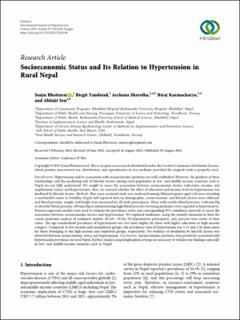| dc.description.abstract | Introduction. Hypertension and its association with socioeconomic positions are well established. However, the gradient of these relationships and the mediating role of lifestyle factors among rural population in low- and middle-income countries such as Nepal are not fully understood. We sought to assess the association between socioeconomic factors (education, income, and employment status) and hypertension. Also, we assessed whether the effect of education and income level on hypertension was mediated by lifestyle factors. Methods. This cross-sectional study was conducted among 260 participants aged ≥18 years attending a rural health center in Dolakha, Nepal. Self-reported data on demographic, socioeconomic, and lifestyle factors were collected, and blood pressure, weight, and height were measured for all study participants. Those with systolic blood pressure ≥140 mm Hg or diastolic blood pressure ≥90 mm Hg or administrating high blood pressure-lowering medicines were regarded as hypertensives. Poisson regression models were used to estimate the prevalence ratios and corresponding 95% confidence intervals to assess the association between socioeconomic factors and hypertension. We explored mediation, using the medeff command in Stata for causal mediation analysis of nonlinear models. Results. Of the 50 hypertensive participants, sixty percent were aware of their status. The age-standardized prevalence of hypertension was two times higher for those with higher education or high-income category. Compared to low-income and unemployed groups, the prevalence ratio of hypertension was 1.33 and 2.26 times more for those belonging to the high-income and employed groups, respectively. No evidence of mediation by lifestyle factors was observed between socioeconomic status and hypertension. Conclusions. Socioeconomic positions were positively associated with hypertension prevalence in rural Nepal. Further studies using longitudinal settings are necessary to validate our findings especially in low- and middle-income countries such as Nepal. | en_US |

